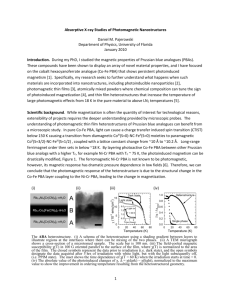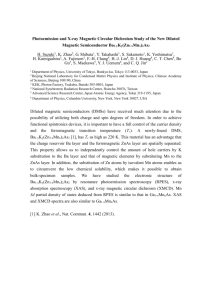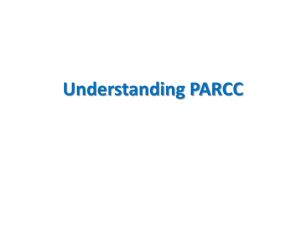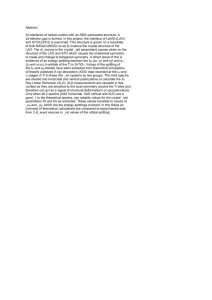Abstract (1300 characters maximum, current abstract is 1357
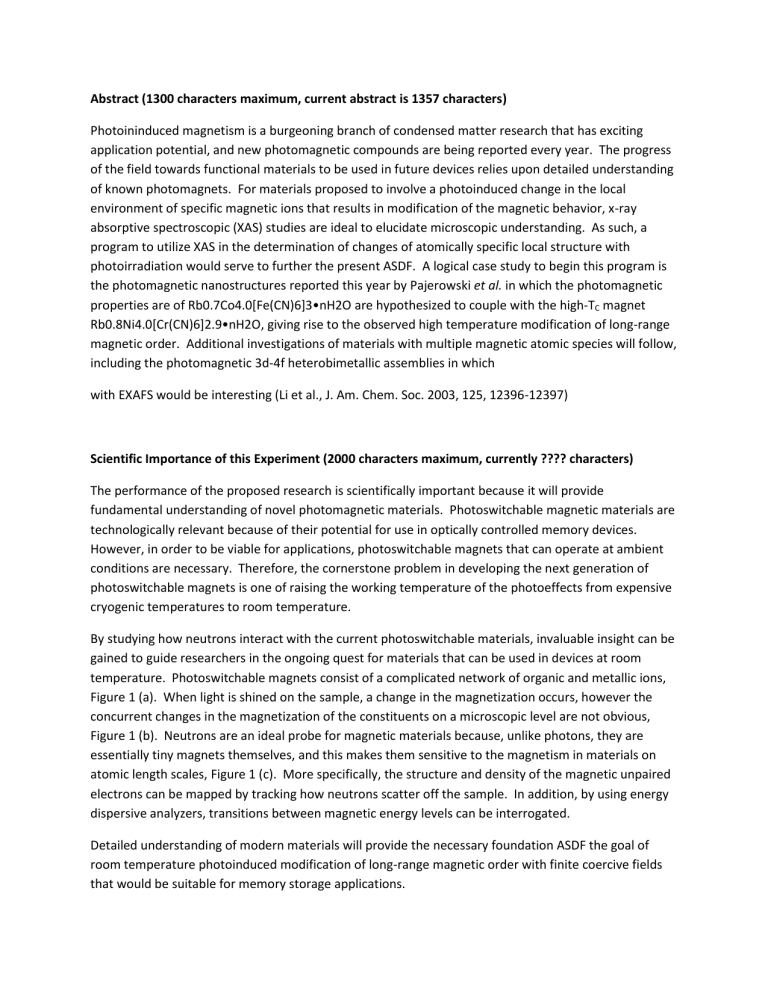
Abstract (1300 characters maximum, current abstract is 1357 characters)
Photoininduced magnetism is a burgeoning branch of condensed matter research that has exciting application potential, and new photomagnetic compounds are being reported every year. The progress of the field towards functional materials to be used in future devices relies upon detailed understanding of known photomagnets. For materials proposed to involve a photoinduced change in the local environment of specific magnetic ions that results in modification of the magnetic behavior, x-ray absorptive spectroscopic (XAS) studies are ideal to elucidate microscopic understanding. As such, a program to utilize XAS in the determination of changes of atomically specific local structure with photoirradiation would serve to further the present ASDF. A logical case study to begin this program is the photomagnetic nanostructures reported this year by Pajerowski et al. in which the photomagnetic properties are of Rb0.7Co4.0[Fe(CN)6]3•nH2O are hypothesized to couple with the high-T
C
magnet
Rb0.8Ni4.0[Cr(CN)6]2.9•nH2O, giving rise to the observed high temperature modification of long-range magnetic order. Additional investigations of materials with multiple magnetic atomic species will follow, including the photomagnetic 3d-4f heterobimetallic assemblies in which with EXAFS would be interesting (Li et al., J. Am. Chem. Soc. 2003, 125, 12396-12397)
Scientific Importance of this Experiment (2000 characters maximum, currently ???? characters)
The performance of the proposed research is scientifically important because it will provide fundamental understanding of novel photomagnetic materials. Photoswitchable magnetic materials are technologically relevant because of their potential for use in optically controlled memory devices.
However, in order to be viable for applications, photoswitchable magnets that can operate at ambient conditions are necessary. Therefore, the cornerstone problem in developing the next generation of photoswitchable magnets is one of raising the working temperature of the photoeffects from expensive cryogenic temperatures to room temperature.
By studying how neutrons interact with the current photoswitchable materials, invaluable insight can be gained to guide researchers in the ongoing quest for materials that can be used in devices at room temperature. Photoswitchable magnets consist of a complicated network of organic and metallic ions,
Figure 1 (a). When light is shined on the sample, a change in the magnetization occurs, however the concurrent changes in the magnetization of the constituents on a microscopic level are not obvious,
Figure 1 (b). Neutrons are an ideal probe for magnetic materials because, unlike photons, they are essentially tiny magnets themselves, and this makes them sensitive to the magnetism in materials on atomic length scales, Figure 1 (c). More specifically, the structure and density of the magnetic unpaired electrons can be mapped by tracking how neutrons scatter off the sample. In addition, by using energy dispersive analyzers, transitions between magnetic energy levels can be interrogated.
Detailed understanding of modern materials will provide the necessary foundation ASDF the goal of room temperature photoinduced modification of long-range magnetic order with finite coercive fields that would be suitable for memory storage applications.
Why Synchrotron Radiation is required (limit 2000 characters including spaces)
While magnetization is often the quantity of interest for technological reasons, extensibility of projects requires the deeper understanding provided by microscopic probes. The understanding of complex photoswitchable materials with multiple magnetic centers requires detailed microscopic studies. For materials in which macroscopic measurements suggest that the photoeffects are a result of photoinduced modification of local environments of specific ions, a microscopic probe capable of atomic specificity that is sensitive to local structure is required. An additional complication for optical materials is a need for high experimental flux capable of detecting small crystals and thin films. Based upon these constraints, x-ray absorption spectroscopy is an ideal probe for this class of photomagnets. This conclusion may be further illustrated by considering the aforementioned photomagnetic heterostructures of Prussian blue analogues in more detail. The nanostructures contain layers of cobalt hexacyanoferrate and nickel hexacyanochromate
A logical case study to begin this program is the photomagnetic nanostructures reported this year by
Pajerowski et al. in which the photomagnetic properties are of Rb0.7Co4.0[Fe(CN)6]3•nH2O are hypothesized to couple with the high-TC magnet Rb0.8Ni4.0[Cr(CN)6]2.9•nH2O, giving rise to the observed high temperature modification of long-range magnetic order. in slightly greater detail. photomagnetic thin film heterostructures of Prussian blue analogues can benefit from a microscopic study. X-ray Absorption Spectroscopy (XAS) is ideal to study these systems because it gives information pertaining to the local environments of specific elements, along with a high experimental flux capable of detecting small samples (i.e. thin films).
Describe work previously performed by Principal Investigator at a synchrotron facility (limit 2000 characters including spaces)
Although I have no previous synchrotron experience, I believe I am in a good position to undertake the proposed project because I have used other (neutron and light) scattering techniques, have experience with the necessary sample environment and I am motivated to extend my expertise. I have experience as a user in a few national labs: the NIST at Gaithersburg, MD, ORNL at Oakridge, TN, and the NHMFL at
Tallahassee, FL. During an internship in the Neutron Scattering Science Division (NSSD) at ORNL during
August 2009, I spent part of my time working on probes for neutron scattering with photoexcitation.
Locally at the University of Florida, I have worked in labs using XRD, TEM, UV-VIS, SQUID magnetometry,
ac-susceptometry, dilution refrigerators, and more. Due to sample environment needs in our SQUID magnetometer, I have made custom optical and rotator probes [10].
List up to three publications you feel will assist in reviewing this proposal: (limit 2000 characters including spaces)
[1] Pajerowski, D. M.; Andrus, M. J.; Gardner, J. E.; Knowles, E. K.; Talham, D. R.; Meisel, M. W. J.
Am. Chem. Soc. 2010, 132, 4058
[6] Moulin, C. C.; Villain, F.; Bleuzen, A.; Arrio, M.; Sainctavit, Ph.; Lomenech, C.; Escax, V.; Baudelet,
F.; Dartyge, E.; Gallet, J; Verdaguer, M. J. Am. Chem. Soc. 2000, 122, 6653
EINAGA PAPER
Research Description
(1)photoirradiation
(2)heterostructure
(3)
Historically, XAS has helped elucidate the local environment of hexacyanides [5]. More recently, XAS has been utilized to investigate the photoinduced magnetism of the pure Co-Fe PBA by examining the fine structure of the L2,3 edges of Co and Fe and the K edge of Co before and after photoirradiation, showing clear changes [6]. In addition, XAS studies of materials analogous to the Ni Cr PBA have been undertaken by tracking the K-edges of Ni and Cr constituents [7 8]. However, no XAS studies have yet been performed on photomagnetic heterostructures. As Cr(CN)6 units are generally more rigid, an experiment might consist of Extended X-ray Absorption Fine Structure (EXAFS) and X-ray Absorption
Near Edge Structure (XANES) studies near the K-edge of Ni, before and after photoirradiation of the PBA heterostructures shown in Figures 1 and 2. Modifications of the Ni spectra after photoirradiation would support the hypothesis that the photoinduced Co-Fe PBA distortion is coupling to the Ni Cr PBA lattice and causing the novel photoeffect in the heterostructures. These experiments will require temperatures below T ~ 50 K with access for an optical fiber to irradiate with visible light from a halogen source. Samples are to be synthesized off site.
Provide sufficient details about your program to justify your request for beam time or facility time.
Include a complete description of the experiments proposed over the next 2 year period (6 cycles). At the bottom of the page indicate your intention to attach a small image file with any supporting figures or diagrams. Maximum size of the image file is 512,000 bytes. Please note that a description of your
proposed plans and accomplishments for the first cycle (four month period) will be requested in another section. (4000 characters including spaces)
Proposed work, plans and accomplishments for Beam Time in the requested cycle for this PASS Form:
(limit 2000 characters including spaces)
For the first cycle, XAS studies of photomagnetic Prussian blue analogue heterostructures, containing layers of cobalt hexacyanoferrate (Co-Fe) and nickel hexacyanochromate (Ni-Cr), are to be performed.
These measurements will require a sample environment capable of reaching temperatures less than approximately 50 K with access for an optical fiber. Experiments will begin with a characterization of the magnetic ions prior to photoirradiation. As the zeroeth order necessity of all experiments is the ability to photoirradiate samples, the well characterized characteristics (XAS…) of the Co-Fe constituents will be checked first. After verification of photoinduced modification of the local environment of Co and Fe ions, the Ni and Cr may be investigated. If changes are observed in the local structure around Ni or Cr after photoexcitation of Co-Fe, the proposed structural coupling between layers giving rise to photocontrol of Ni-Cr will be confirmed. Furthermore, the precise nature of the modifications to the
Ni-Cr structure will be elucidated by the results. Lastly, One important reason to begin with these samples is that they are readily synthesized by the PI in the short term in quantity. If distortions in Ni or
Cr are not found with irradiation, this would be surprising ASDF but important ASDF rule out the presently accepted mechanism ASDF detailed understanding requires more studies.
Need to test setup
Use co-fe compared with known results to test setup, co
Then use same setup to test ni and cr
Historically, XAS has helped elucidate the local environment of hexacyanides [5]. More recently, XAS has been utilized to investigate the photoinduced magnetism of the pure Co-Fe PBA by examining the fine structure of the L2,3 edges of Co and Fe and the K edge of Co before and after photoirradiation, showing clear changes [6]. In addition, XAS studies of materials analogous to the Ni Cr PBA have been undertaken by tracking the K-edges of Ni and Cr constituents [7 8]. However, no XAS studies have yet been performed on photomagnetic heterostructures. As Cr(CN)6 units are generally more rigid, an experiment might consist of Extended X-ray Absorption Fine Structure (EXAFS) and X-ray Absorption
Near Edge Structure (XANES) studies near the K-edge of Ni, before and after photoirradiation of the PBA heterostructures shown in Figures 1 and 2. Modifications of the Ni spectra after photoirradiation would support the hypothesis that the photoinduced Co-Fe PBA distortion is coupling to the Ni Cr PBA lattice and causing the novel photoeffect in the heterostructures. These experiments will require temperatures below T ~ 50 K with access for an optical fiber to irradiate with visible light from a halogen source. Samples are to be synthesized off site.
Xxxxxxxxxxxxxxxxxxxxxxxxxxxxxxxxxxxxxxxxxxxxxxxxxxxxxxxxxxxxxxxxxxxx
Nanometer scale heterostructures of Prussian blue analogues lead to new phenomena not observed for the constituent bulk phases [1 2]. A striking example [1] is the heterostructured thin film comprised of the high TC (~ 75 K) Rb0.8Ni4.0[Cr(CN)6]2.9•nH2O (Ni-Cr PBA) and the photomagnetic
Rb0.7Co4.0[Fe(CN)6]3•nH2O (Co-Fe PBA), Figure 1. The ABA (A = Ni Cr PBA, B = Co Fe PBA) films experience a significant increase in the temperature, from 18 K to 75 K, at which large persistent photoinduced changes in magnetization occur. The behavior results from a new mechanism for inducing magnetization changes in molecule-based magnetic materials using light. Light induced structural changes in the Co-Fe PBA layer couple to the adjacent network, leading to changes in magnetization in the higher ordering temperature Ni-Cr PBA.
The control of magnetic properties using optical stimulus has emerged as an area of research that has attracted considerable attention in recent research. This is partly due to it
� potential such as magneto-optic devices as well as novel phenomena itself. A new impetus to this field has been given by discoveries of materials in which photoinduced magnetic phenomena coexist with cooperative magnetic behavior and/or magnetic order. These novel materials include Prussian blue analogs, diluted magnetic semiconductors, doped manganites, and spin ferrite films.
